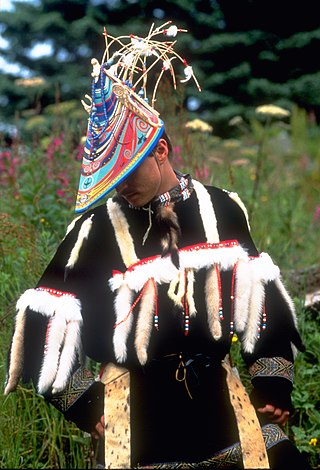Related Research Articles
Peter Kalifornsky was a writer and ethnographer of the Dena'ina Athabaskan of Kenai, Alaska.

The Alutiiq people, also called by their ancestral name Sugpiaq, as well as Pacific Eskimo or Pacific Yupik, are one of eight groups of Alaska Natives that inhabit the southern-central coast of the region.

Ronald Senungetuk was an Iñupiaq artist originally from Wales, Alaska, who worked primarily in wood and metal.
Claire Specht Fejes was an American artist.

The Anchorage Museum is a large art, history, ethnography, ecology and science museum located in a modern building in the heart of Anchorage, Alaska. It is dedicated to studying and exploring the land, peoples, art and history of Alaska.
Joan Arend Kickbush was a popular Alaskan artist. Her paintings and illustrations featured Alaska Native children, Yupik villagers and Arctic wildlife. She painted in watercolor and oil.
The Alutiiq language is a close relative to the Central Alaskan Yup'ik language spoken in the western and southwestern Alaska, but is considered a distinct language. It has two major dialects:
Larry Beck, full name Lawrence James Beck, was an American sculptor born in Seattle, Washington. Beck was one quarter Native Alaskan, a cause of both conflict and inspiration during his career. His work ranged from industrial assemblages and happenings in the 60's to large, abstract public commissions in the 70's to Yup'ik masks inspired by traditional Yup'ik pieces, but rendered with modern industrial and manufactured materials which he began in the 80's and was working on up until his death.

Frances Ann Reed was an American fiber artist and teacher based in Alaska who specialized in a distinctive style of basketry made from dried fish skins and other natural materials found in the state.
Robert James "Jim" Schoppert was an Tlingit Alaska Native artist and educator. His work includes woodcarving, painting, poetry, and essays. He has been described as an innovator, whose works pushed the boundaries of what was expected from Northwest Coast art.
The Native Art Center at the University of Alaska Fairbanks is an art school located at the University of Alaska Fairbanks (UAF), near Fairbanks, Alaska. The Native Art Center was started in 1966 by Ronald Senungetuk (Iñupiaq). Today, the Native Art Center is directed by Da-ka-xeen Mehner (Tlingit-Nisga'a) and offers BFA and MFA degrees in Native Art.

Michael Nakoneczny is an American artist. He lived in Chicago for over twenty years. He is currently teaching painting at the University of Alaska in Fairbanks, Alaska. Michael has received numerous awards including a Rasmuson Foundation Grant, Illinois Art Council Fellowship and an Arts Midwest/NEA Regional Fellowship. He received a BFA from Cleveland State University and an MFA from the University of Cincinnati. Michael Nakoneczny is represented by Zolla/Lieberman Gallery, Inc., Chicago, IL. and Grover Thurston Gallery in Seattle, WA.

Daniel P. Pierce was a painter, printmaker and sculptor. He founded the University of Alaska’s art department in 1960 and retired as professor emeritus of art from the University of Wisconsin, Milwaukee. In 2012, he received an honorary doctorate of arts from the University of Alaska-Fairbanks in recognition of his accomplishments as an artist and educator and for his contributions to the practice of art in Alaska.

Nicholas Galanin is a Tlingit and Unangax̂ multi-disciplinary artist and musician from Alaska. His work often explores a dialogue of change and identity between Native and non-Native communities.
Kesler Edward "Kes" Woodward is an American artist, art historian and curator. Known for his colorful paintings of northern landscapes, he was awarded the first Alaska Governor's Award for Lifetime Achievement in the Arts in 2004. Woodward has also written extensively on the Art of the circumpolar North and has curated exhibitions which have toured Alaska, California, Oregon, Washington, and Georgia.

Unangan hunting headgear are wooden hats associated with the Unangan or Unangas, the Indigenous peoples of what are currently known as the Aleutian Islands.
Mary Rosanne Katzke is an American filmmaker, writer, and photographer known for Alaska-based documentaries bringing attention to various social and healthcare issues, including sexual assault, domestic violence, mental illness, homelessness, Alzheimer's disease, traumatic brain injury and breast cancer. Since 1982, she has produced four dozen grant-funded documentaries through her nonprofit production company Affinityfilms.
Linda Anne Infante Lyons is a Native American visual media artist from Anchorage, Alaska. She is Alutiiq, with her mother's family descending from Kodiak Island, and Estonian. The island's natives experienced two waves of colonization, which plays a central role in Lyons' artwork.

Hannah Paul Solomon was an American community leader and artist. She was the first female mayor of Fort Yukon, Alaska, helped organize the Fairbanks Native Association, and was inducted into the Alaska Women's Hall of Fame in 2012. Her traditional beadwork is in the collections of several museums.
Da-ka-xeen Mehner is a Tlingit/Nisga'a American visual artist whose work includes photography and multimedia installations that incorporate video, sculpture and sound.
References
- ↑ "Faculty: Alvin Amason". University of Alaska Anchorage. Archived from the original on 1 May 2020.
- ↑ "2018 Award Winners". Governor's Arts and Humanities Awards. Archived from the original on 1 May 2020.
- ↑ "Alvin Eli Amason". askART. April 2003. Archived from the original on 1 May 2020.
- ↑ "Our 2018 Distinguished Artist is Alvin Amason". Rasmuson Foundation. 10 May 2018. Archived from the original on 1 May 2020.
- ↑ "Artist Information: Alvin Amason". Heard Museum, Native American Artists Resource Collection Online. Archived from the original on 1 May 2020.
- 1 2 3 "1% for Art - Municipality of Anchorage, Listing by Location as of December 31, 2017" (PDF). Municipality of Anchorage. 31 Dec 2017. Archived (PDF) from the original on 2 May 2020.
- ↑ "Artist Talk and Film: Alvin Amason - Everything I Love is Here". Anchorage Museum. 2018. Archived from the original on 2 May 2020.